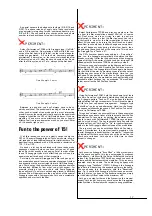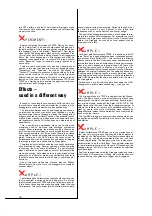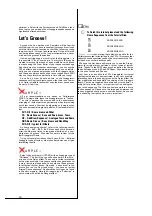
5
Introduction
®
Now that you have unpacked your
CS1x, placed it onto a firm surface and
wired up and plugged everything in cor-
rectly, we would like to accompany you
a little during this first contact with your
new synthesizer. Naturally you will want
to listen to the demo songs straight
away to get a feel for the tonal possibili-
ties of the CS1x.
First steps – Listening
to the Preset sounds
and Demos
Press the Performance and Multi keys simultaneously. You
can now hear the first song “FRIDGE”, all the other
sequences will follow automatically. You can of course man-
ually select each of these song examples via the numeric
pad.
A total of
8 demos are available. Although each sequence
is primarily concerned with showing the CS1x in its best
light, the sequences are still quite different: by tradition, the
first four demos (0-3) set out to prove the song production
abilities of the CS1x and it‘s possibilities as a stand-alone
workstation, whilst the remaining songs deal with the CS1x‘s
more outstanding features. Here is a quick description:
Knob Tech (4):
Sequences that demonstrate real-time
knob control for Dance & Techno productions.
(programmed by Peter Krischker, YE)
Analuner (5):
Synthesizer sounds of the 70‘s and 80‘s. If
you appreciate classic vintage sounds you must take a listen
to this demo.
(programmed by Johannes Waehneldt, YE).
Arp Tech (6):
Here you will hear one of the CS1x highlights,
the Arpeggiator. Unusual sequences and likewise sounds.
(programmed by Johannes Waehneldt, YE).
Transit (7):
We finish on a few sequences that again de-
monstrate the real-time control and modulation possibilities
of the CS1x.
(programmed by Johannes Waehneldt, YE).
The factory preset sounds chosen for the CS1x clearly
emphasise its synthesizer character. If you are at all unsure
to what uses a particular sound may be applied, let yourself
be guided by the sound‘s category (Sq=Sequencer,
Ba=Bass, Pf=Piano etc. – more about this can be found in
the manual).
Try this out at all cost: The CS1x Arpeggiator already
shines brightly with the first 12 Performances. Press any key
and listen how the Arpeggiator translates the note. To under-
stand this better, switch the Arpeggiator off (key bearing the
same name, to the top left of the LC-Display). Also, try using
the unique Scene switches (just above the two wheels) with
the preset sounds straight away; first press one, than the
other, and finally both simultaneously, and use the Mod
wheel, too. It‘s best to aquaint yourself with the CS1x Con-
trol knobs right from the start. Take particular note of the
different Assign 1/2 settings (=Knob3/6). These will no
doubt give you plenty of ideas for your own sounds.
If you‘re inclined to head straight for the more traditional
piano, organ or string sounds, don‘t panic – here, too the
CS1x is at home. After all, it contains all the GM/XG sounds.
If you have not yet come across these sounds, why not press
the MULTI key. You can now try out the most important XG
voices using the PROGRAM keys (bottom left of the LC-Dis-
play) in your own time. Be advised however that all sounds
initially utilise only a reverb effect.
More conventional sounds, complete with Layer and
effect settings can be found in the Preset bank‘s last few
memories (beginning with P078). By the way, several of the
Blue Book sections will look at the factory sounds in more
depth.
At a glance
Techno and Dance have heralded the comeback of ana-
logue synthesizers more then any other music style. Whilst
trying out some of its Presets you will already have come
across some of the many exemplary analogue type sounds
the CS1x has to offer. Without a doubt, the range of sounds
available is pretty good! It‘s even better however to be able
to shape Performances to get the required result, or program
one from scratch.
Starting out is never easy. That is why we would like to
begin with an easy to understand tutorial which covers the
most important components of the classic synthesizer, the
“
A nalogue Workshop
”. Let us introduce you to the wonder-
ful world of synthesizer programming with the CS1x. As an
extra special treat, a complete sound bank (“TUTORI-
ALPFM.MID”) with detailed sound examples awaits you
inside. We thought it best to save you from the tedious task
of manually punching in data. You will be able to concentrate
fully on the material at hand and replicate each given exam-
ple directly on your CS1x.
It doesn‘t really matter whether you have already worked
with various analogue synthesizers, or if you have never even
heard of this feature – the integrated CS1x Arpeggiator will
simply knock your socks off: compared to earlier Arpeggia-
tors, the CS1x raises the stakes with complete arrangement
structures, including Filter, Pan position modulation and the
like. Enough to awaken any musician‘s playing instinct.
However, to use this feature effectively you should fully
familiarise yourself with all its possibilities and the required
procedures. The next chapter of the
Blue Book
will take
you through all the steps you need to consider when using
the Arpeggiator function. That‘s why an intuitive user inter-
face is so important, so that you don‘t get lost in a myriad of
menus. The CS1x is totally deserving of its “Control Synthe-
sizer” title in this respect. Its six controllers add particular
weight to this claim: The Sound Control Knobs can be
assigned to aid performance in many different ways using
the Utility mode (see the chapter about song production
basics, section “Who is controlling Who?”). Worthy of atten-
tion also are the two Scene switches that are used to ‘freeze’
two complete controller positions which can then be ‘mor-
phed’ into each other. You will find useful examples of this in





















